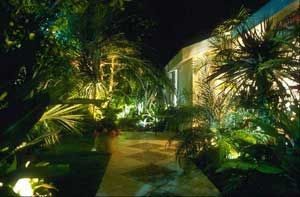 Outdoor Landscape Lighting For The Dallas Homeowner
Outdoor Landscape Lighting For The Dallas Homeowner
Let your landscape lighting illuminate every occasion and invite people into your home safely and beautifully – highlighting walkways, architectural elements, gathering spaces, water features and more. A landscape lighting professional can show you all of the possibilities and deliver the best, most efficient lighting to bring your home to life.
Landscaping lighting enhances your home’s look and safety. Exterior lighting includes flood lights, path lights, spotlights and more.
How to Install Landscape Lighting
While at first glance, installing landscape lights may seem straightforward – plug, wire, and go – in fact there are a lot of elements in the process that aren’t intuitive at all. Lighting is usually installed by a professional as part of the overall landscape installation. Here, landscape contractors share the process they use to install outdoor lights.
Step 1: Assemble the landscape lighting fixtures and insert the bulbs. Remember to not touch the halogen lights directly with your fingers since grease from your skin may shorten the life span of the bulbs.
Step 2: Place thelighting fixtures in the ground following your design. Try to keep your lights hidden by shrubbery and outdoor items for aesthetic appeal. When the light source is hidden, the light is showcased rather than the fixture.
Step 3: Run the cable from the transformer to your landscape lighting fixtures. Lay the transformer on the ground and do not mount the it at this time. Leave at least 5 feet of slack by the transformer, then loosely run the cable to each fixture according to your layout.
Step 4: Create your splices. Use a Direct Burial (DBr) splice connector to connect each landscape lighting fixture to the cable. Do not use wire nuts because they will easily corrode. Since low voltage landscape lighting fixtures don’t have a polarity, it doesn’t matter which fixture gets paired with which cable wire. You can choose to use a Hub System to centralize all your cable splices which will make future troubleshooting much easier.
Step 5:Connect the wires to the transformer while it is not mounted to the wall. One wire from each run will go to the common terminal, and one will go to the 12 volt tap terminal. These terminals are labeled on the transformer, and each can have multiple wires connected to it. Do not use the higher tap voltage terminals at this time, we’ll get to that next. Once each wire is connected, you can plug in the transformer.
Step 6: Double check your lights and layout. If one light is dim, move that zone’s cable to a higher tap terminal on the transformer. Use a volt meter to determine which volt tap will create the optimum 11-12 volts. If all fixtures on a run aren’t within 1.5 volts of each other, adjust your layout or break the run into two. Measure the farthest fixture in each run first, then work your way inward. If your run is more than 15 volts, professional assistance is strongly recommended. Read more.
The Advantages of Landscape Lighting
Plants often take center stage when it comes to landscaping, but exterior lighting adds both aesthetic and functional benefits to your home. Landscape lighting ranges from small solar lights that need no wiring to wall-mounted lights that are hardwired into your home’s electrical system. Understanding the advantages of outdoor lighting helps you choose the type of lighting that matches your needs. Call (214) 238-8353 us for your home service and repair needs.
For more related articles and info visit https://www.berkeys.com/category/electrical/
